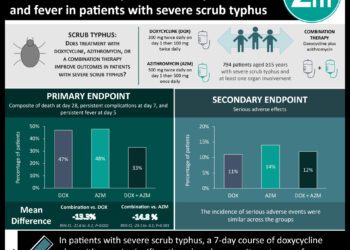Patient Basics: Fever
Originally published by Harvard Health.
What Is It?
A fever is an increase in body temperature above the normal range. However, body temperature varies between people, with different levels of activity and at different times of the day. Medical textbooks differ in their definition of the highest normal body temperature. Fever generally can be defined as an early morning temperature higher than 99 degrees Fahrenheit or a temperature higher than 100 degrees Fahrenheit at any time of the day.
A part of the brain called the hypothalamus acts as the body’s thermostat. When all is well in the body, the hypothalamus is set at the normal body temperature. Fever develops when the hypothalamus is set to a higher-than-normal temperature. This resetting of the hypothalamus is usually caused by small molecules called pyrogens in the blood. Pyrogens can come from outside the body (external) or can be produced inside the body (internal). External pyrogens include toxins (poisons) produced by infectious viruses or bacteria. Internal pyrogens include abnormal chemicals that are produced by tumors and proteins that are released during the normal response of the immune system.
Causes of fever include:
- Hundreds of types of viruses, bacteria and parasites that cause many illnesses, such as upper respiratory infections, pneumonia, diarrhea and urinary tract infections
- Chronic (long-term) conditions associated with inflammation, such as rheumatoid arthritis
- Severe trauma, including surgery
- Reactions to medications or immunizations
- Certain types of cancers
Symptoms
Common symptoms associated with fever include sweating, shivering, headaches, muscle aches, poor appetite, rash, restlessness and general body weakness. High fever can lead to symptoms of mental dysfunction, such as confusion, excessive sleepiness, irritability and convulsions (seizures).
Convulsions triggered by fever (febrile seizures) are common among children younger than 5 years. These seizures usually occur at the beginning of an illness when temperature rises rapidly. In infants and toddlers, febrile seizures typically cause muscle rigidity and generalized convulsions that last less than 15 minutes. A febrile seizure usually is followed by a long period of sleep.
Specific symptoms associated with a fever often can provide clues to help identify the fever’s cause. For example, a fever accompanied by vomiting and diarrhea may signal gastroenteritis, and a fever associated with coughing, shortness of breath and grayish-yellow phlegm may indicate pneumonia.
Diagnosis
In pinpointing a fever’s cause, your doctor may ask about:
- Cold or flu symptoms
- Abdominal pain, nausea, vomiting or diarrhea
- Burning or pain with urination
- Pain or discomfort in any part of your body
- Contact with sick people at home, work or school
- The types of food you’ve eaten recently
- Any recent exposure you have had to animals, including pets
- Whether you have any implanted prosthetic or mechanical device, such as an artificial joint or mechanical heart valve
- Any recent surgery, cuts or large areas of broken skin
- Chronic inflammatory conditions, such as rheumatoid arthritis
- The types of medications you take
- Recent immunizations
- Recent travel, especially to a foreign country
Your doctor will take your temperature orally, in the ear canal or rectally. Depending on the suspected site of infection, your doctor may then examine your:
- Skin — For signs of rash or infection
- Lymph nodes — For swelling (a sign of nearby infection)
- Eyes — For redness or jaundice (yellowing of the whites of the eyes)
- Mouth and throat — For signs of pharyngitis (throat infection) or a tooth abscess
- Cardiovascular system — For heart failure or infections involving the heart
- Chest — For lung infection
- Abdomen — For infections of the gallbladder, intestine or appendix
- Joints — For arthritis
- Genitals — For sexually transmitted diseases
- Nervous system — For encephalitis (brain infection) or meningitis (inflammation or infection involving the membranes covering the brain)
Depending on your symptoms and the results of your physical examination, you may need diagnostic tests, including laboratory examination of body fluids (blood, urine, stool or spinal fluid); special X-rays or scans; or a biopsy (taking a sample of body tissue for laboratory examination).
Expected Duration
Depending on its cause, a fever may disappear in a day or last for weeks.
Prevention
You can reduce your risk of getting illnesses that cause fever by adopting these healthy habits:
- Practice good hygiene by washing your hands frequently with soap and warm water, especially after using the toilet and before eating.
- Limit exposure to crowds and to people with known infections.
- Cook and store foods properly to avoid food poisoning.
- Keep a record of your current immunizations. Review this record with your doctor every year to confirm that your immunizations are up-to-date.
- Contact your doctor before traveling to a foreign country to receive any recommended immunizations before your trip.
Treatment
Doctors often advise adults with mild to moderate fevers below 102 degrees Fahrenheit to:
- Drink plenty of water and fruit juices to prevent dehydration (abnormally low levels of body water). Fluids help to cool your body and they replenish vital salts and minerals (electrolytes), which may be lost during vomiting or diarrhea.
- Eat light foods that are easy to digest.
- Get plenty of rest.
- Take ibuprofen (Advil, Motrin or others), acetaminophen (Tylenol) or aspirin according to label directions. Fever may help to fight infection, so there is a controversy about whether fever should be treated routinely or only if it is particularly severe.
Aspirin should not be given to infants and children younger than age 16 because of the risk of Reye’s syndrome, a life-threatening neurological disorder that can develop when children take aspirin during a viral illness. In children, reduce fever by using acetaminophen or ibuprofen, together with lukewarm sponge baths. If your child has a febrile seizure, call your doctor immediately.
If your doctor suspects that a bacterial infection is causing your fever, he or she will prescribe antibiotics.
When To Call a Professional
Adults and children should seek immediate medical attention for any fever of 104 degrees Fahrenheit or higher or for any fever accompanied by one or more of the following:
- Convulsion
- Loss of consciousness
- Confusion
- Stiff neck
- Difficulty breathing
- Severe pain anywhere in the body (especially the head, chest or abdomen)
- Swelling or inflammation of any part of the body
- Vaginal discharge that is discolored or foul-smelling
- Urinary tract symptoms (pain on urination, foul-smelling urine)
Call a doctor immediately if an infant younger than 3 months develops any fever.
For a lower fever of unexplained origin, call your doctor if it does not improve after two to three days. Call sooner if you develop additional symptoms.
Prognosis
For most fevers caused by common infections, the person either recovers on their own or the doctor is able to identify and treat the cause.
Sustained body temperatures of 106 degrees Fahrenheit or above can cause brain damage.
Additional Info
American Academy of Family Physicians (AAFP)
11400 Tomahawk Creek Parkway
Leawood, KS 66211-2672
Phone: 913-906-6000
Toll-Free: 1-800-274-2237
http://www.familydoctor.org/





